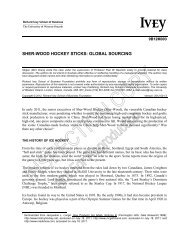foundation of canada asia pacific - Content Tagged with
foundation of canada asia pacific - Content Tagged with
foundation of canada asia pacific - Content Tagged with
Create successful ePaper yourself
Turn your PDF publications into a flip-book with our unique Google optimized e-Paper software.
6<br />
DEVELOPMENT ASSISTANCE<br />
ODA for a<br />
borderless world<br />
59<br />
Canadians are a generous people, both in our self-image and in the real world. We believe<br />
in helping those less well <strong>of</strong>f than ourselves. As a middle-sized economic power, and a<br />
strong advocate <strong>of</strong> cooperative welfare programs, Canada has always sought to use some<br />
<strong>of</strong> its national wealth to help the people <strong>of</strong> less developed countries through <strong>of</strong>ficial<br />
development assistance (ODA). Unfortunately, at a time <strong>of</strong> budget restraint, we have<br />
been forced to curb our ambitions to match the resources available to meet them. This<br />
has been a frustrating task. One result is that Canada’s ODA as a share <strong>of</strong> GNP has declined<br />
sharply. From a high <strong>of</strong> 0.49% in 1991-92, the share fell to about 0.29% in 1998-99, the<br />
lowest in almost 30 years. In that time, Canadian ODA to Asia fell more than 40%. It is<br />
unlikely that the government will reach its commitment <strong>of</strong> allocating 0.7% <strong>of</strong> GNP to<br />
ODA any time soon, even though it has pledged more resources to international assistance<br />
in the 2000 budget. At the same time, there is a new challenge emerging for our<br />
international assistance program which affects not only how much we spend on ODA, but<br />
what it is we spend it on and how we deliver the aid. In the globalized economy, there<br />
are new needs to meet and alternate ways <strong>of</strong> addressing them. This has seen a variety <strong>of</strong><br />
government departments and agencies become newly involved in international assistance<br />
programs. It has reached a point where we must develop a partnership approach to the<br />
delivery <strong>of</strong> aid so that different arms <strong>of</strong> the Canadian government do not overlap or compete<br />
in the planning and delivery <strong>of</strong> projects.<br />
Today, borders mean less than ever to the flow <strong>of</strong> goods and money. This applies to ODA<br />
as much as it does to commerce. It means that Canada is sometimes helping developing<br />
economies as a group or across a region rather than as individual countries, which are the<br />
traditional focus <strong>of</strong> ODA. Cross-border needs that hardly existed a decade ago are now<br />
attracting attention. To meet these new needs, Canada’s aid delivery has become more<br />
diffuse, <strong>with</strong> many government departments and agencies increasingly involved in<br />
international projects. Asia is at the centre <strong>of</strong> this evolution. The emergence <strong>of</strong> the<br />
cooperative, if unfocused, approach <strong>of</strong> APEC to regional development has been the catalyst<br />
for much <strong>of</strong> this change. Government departments which until a few years ago had a<br />
purely domestic mandate are becoming involved in overseas cooperation projects, driven<br />
by their participation in APEC working groups or reacting to international regulatory<br />
requirements set out in agreements like the Kyoto Convention. One result is a growing<br />
concern about overlapping commitments by different arms <strong>of</strong> government.



